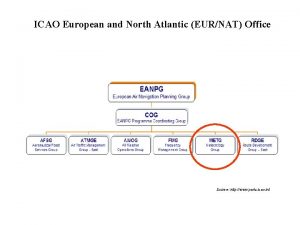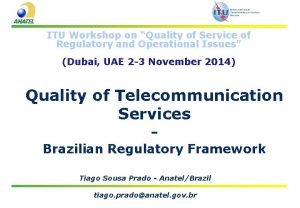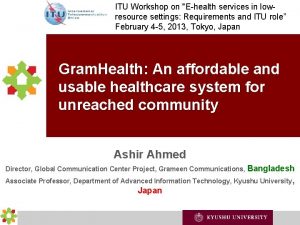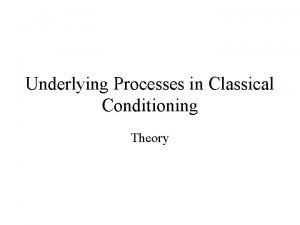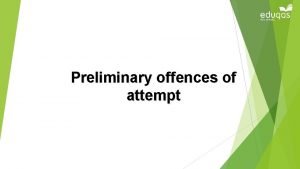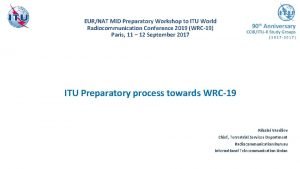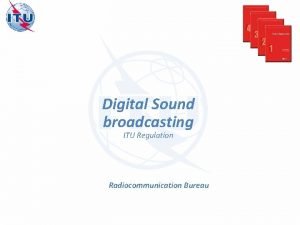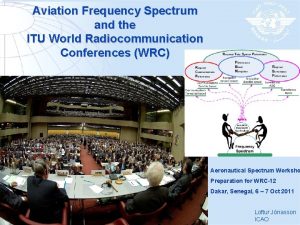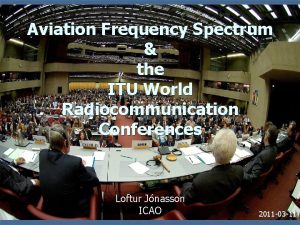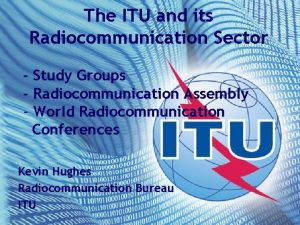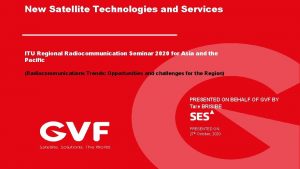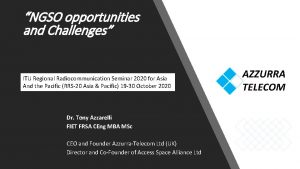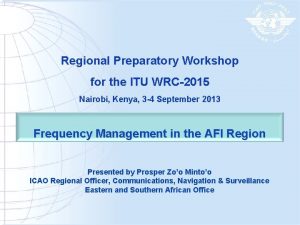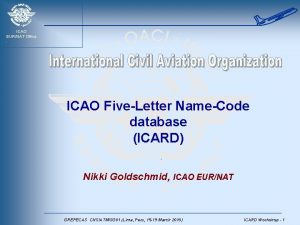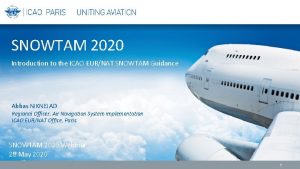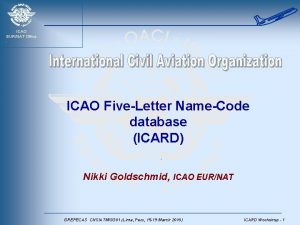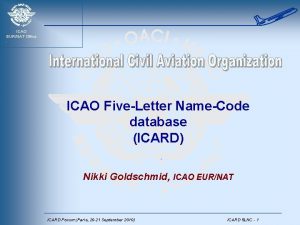EURNAT MID Preparatory Workshop to ITU World Radiocommunication




















- Slides: 20

EUR/NAT MID Preparatory Workshop to ITU World Radiocommunication Conference 2019 (WRC-19) Paris, France, 11 -12 September 2017 CEPT deliberations on the Potential accommodation of wireless Microphones and In-Ear Monitors Programme Making and Special Events (PMSE), targeting to share the 960 – 1164 MHz band Raffi KHATCHERIAN Spectrum Manager

What is Programme Making and Special Event PMSE § Wireless Microphones and in Ear Monitors § § § Freedom of movement Equipment worn on the body Flexibility: hold events in almost any location Significantly reduce installation costs Monitor Infrastructure: § it is not uncommon to find 50 wireless microphones and monitors on a stage § Eurovision more than 600 channels § Quality requirements § high quality spectrum § duty cycle 100% § Real time audio transmission PMSE sharing the 960 - 1164 MHz band 2

EC Digital Dividend § Promoting the shared use of Europe's radio spectrum § The EU's Radio Spectrum Policy Programme (RSPP) sets out the framework, based on the principle that spectrum should be used efficiently PMSE sharing the 960 - 1164 MHz band 3

Offer / Demand § § Market mechanisms to regulate spectrum Make communications markets work for everyone Promote competition and ensure that markets work effectively Efficient use of the limited spectrum resource PMSE sharing the 960 - 1164 MHz band 4

PMSE wireless Microphones & in Ear Monitors Sharing the Frequency Band 960 -1164 MHz UK Ofcom’s perspective § Make the 700 MHz frequency band available for mobile data, release the 700 MHz band in Q 2 2020 § Government grant scheme to support PMSE users who will have to vacate the 700 MHz band § Planning criteria that will ensure the protection of DME/TACAN from PMSE § Insufficient testing to ensure the protection of SSR/TCAS/ADS-B from PMSE; a ± 15 MHz guard band would be used around 1030 & 1090 MHz § PMSE licenses are time, location and frequency specific § Spectrum Management Rules to minimise the risk of harmful interference to aeronautical systems in the 960 -1164 MHz band PMSE sharing the 960 - 1164 MHz band 5

Why Sharing the 960 -1164 MHz band § Global Harmonisation – engagement with other administrations for widespread adoption § To avoid fragmentation in the use of spectrum for wireless microphones § No change compared to current PMSE equipment / practices § Cost of PMSE equipment kept low § Propagation characteristics PMSE sharing the 960 - 1164 MHz band 6

Is there other candidate bands for audio PMSE ? § Draft Amended ERC Recommendation 25 -10 Table 2: frequency ranges for use by audio PMSE applications Type of link Frequencies/Tuning ranges A 1: 29. 7 -47. 0 MHz Technical information See ERC/REC 70 -03 [5], Annex 10 A 2: 174 -216 MHz See ERC/REC 70 -03, Annex 10 A 3: 470 -694 MHz See ERC/REC 70 -03, Annex 10 CEPT Report 60 [6] A 4: 694 -790 MHz Radio microphones and In-ear monitors A 5: 823 -832 MHz See ERC/REC 70 -03, Annex 10 and EC Decision 2014/641/EU [9] A 6: 863 -865 MHz See ERC/REC 70 -03, Annex 10 and EC Decision 2013/752/EU [10]. A 7: 1350 -1400 MHz See ECC Report 245 ERC/REC 70 -03, Annex 10 [Draft] ECC Report 253 A 8: [1518 -1525 MHz] A 9: 1785 -1805 MHz See ERC/REC 70 -03, Annex 10 and EC Decision 2014/641/EU [9] Background information Non-professional PMSE use. Legacy systems still in use. No broadcast quality equipment available. Shared use. ETSI EN 300 422 [8]. Shared use. EN 300 422. Core band for professional use. Shared use. EN 300 422. Currently a core band for professional PMSE use. Changes to the band will limit its utility for PMSE. The extent of the impact is dependent on national decisions (see ECC/DEC (15)01 [7]). Shared use. EN 300 422. Risk of out of band emissions from adjacent mobile services means there is limited utility for broadcast quality audio Harmonised (within EU member states). EN 300 422. Risk of out of band emissions from adjacent mobile services and other short range devices means there is very limited utility for broadcast quality audio. Shared use. Note 1. EN 300 422 and EN 301 357 [11]. Newly recommended tuning range in 2016. Shared use EN 300 422 [Newly recommended tuning range in 2016. Shared use EN 300 422] Harmonised (within EU member states). EN 300 422. § 1525 -1559 MHz also addressed in UK Ofcom’s public consultation PMSE sharing the 960 - 1164 MHz band 7

Is there other candidate bands for audio PMSE ? § § Above 6 GHz Primary allocation to PMSE Long term solution Preserve investments Significant change compared to current PMSE equipment / practices; But insignificant compared to the aviation sector’s efforts if PMSE share the 9601164 MHz band PMSE sharing the 960 - 1164 MHz band 8

PMSE Spectrum requirements § Spectrum requirements varies significantly between States § Average daily requirements for social / cultural events: 40 to 94 MHz § 2012 Olympics: 400 MHz PMSE sharing the 960 - 1164 MHz band 9

When and for how long § Equipment already available on the market § Possible to get one on the web for less than 200€ § PMSE users, manufacturers requesting long-term implementation (15 - 20 years) § http: //www. goodluckbuy. com/lawmate-1 -2 ghz-8 ch-1000 mw-wireless-avtransmitter-vtx-and-receiver-vrx-for-fpv-cctv-camera. html PMSE sharing the 960 - 1164 MHz band 10

Potential impact on DME in case of PMSE interference § 1 st Hypothesis: PMSE transmitter is jamming only one DME ground station. § The DME on board receiver will transmit Non Computed Data (NCD) to the aircraft systems for this Ground Station § DME distance and Ident, will disappear from the Navigation Displays and will be replaced by dashes § That DME ground station cannot be used by the FMS for Radio position computation § If no other adequate ground station(s) available, it will lead to the loss of aircraft radio position § 2 nd Hypothesis: PMSE transmitter is jamming on-board DME receiver § The DME on board receiver will transmit NCD to the aircraft systems, including FMS, for all DME Ground Stations and the radio aircraft position will be lost § DME distance(s) and Ident will disappear from the Navigation Displays and will be replaced by dashes PMSE sharing the 960 - 1164 MHz band 11

Typical Aircraft architecture GNSS, DME and FMS § The PMSE interference in the 960 -1164 MHz band could create noise on aircraft DME receivers, leading to the loss of the Aircraft radio position and to the degradation of aircraft operational performances (loss of DME distances display). This can become critical in case of difficult conditions such as bad weather, low flight altitude. PMSE sharing the 960 - 1164 MHz band 12

Current Civil/Military systems operating in the band § Is globally allocated to ARNS, AM(R)S, and AMS(R)S Earth-to-space. § Prime radionavigation band, used intensively, and extensively § § § Distance measuring equipment (DME) Secondary Surveillance Radar (SSR); SSR Modes (A, A/C, S) Automatic Dependent Surveillance-Broadcast (ADS-B) Universal Access Transceiver (UAT) Multilateration systems (MLAT); Wide area multilateration (WAM) ACAS/TCAS : Airborne Collision Avoidance System RSBN (similar to ILS, VOR, DME and TACAN) Identification Friend or Foe (IFF) Tactical Air Navigation (TACAN) Joint Tactical Information Distribution System (JTIDS) / Multifunctional Information Distribution System (MIDS) Future systems in the band: § ACAS-Xu, ACAS-Xp, § L-band Digital Aeronautical Communication System (LDACS) § Remotely Piloted Aircraft System (RPAS) C 2 link § Systems operating in this band comply with aviation safety requirements § High level predictability of systems in place § Current aeronautical use of the band will increase PMSE sharing the 960 - 1164 MHz band 13

Impact on Civil/Military Aviation § Opening the band to commercial, non-safety terrestrial applications represents a fundamental change that will have significant economic impact, as civil aviation equipment / procedures would need to be changed to accommodate new failure mechanisms. § Negative impact on Capacity; reduction of Military channels § PMSE industry can claim protection from Civil/Military Aviation § Significant cost for coordinating and monitoring the band § Loss of flexibility for aviation current and future systems § Slow down / freeze future aviation modernisation programmes § Severe financial and ecological consequences on aviation § Safety risks; Legal and Liability issues § The proliferation of commercial equipment targeting the band may lead to an uncontrolled illegal usage, not compatible with the safety requirements of aeronautical systems § The severity of occurrences resulted by interference in this band should invite decision makers and regulatory authorities to more precaution PMSE sharing the 960 - 1164 MHz band 14

ITU Constitution (CS) § CS Article 40 : Priority of Telecommunications Concerning Safety of Life : 191 International telecommunication services must give absolute priority to all telecommunications concerning safety of life at sea, on land, in the air or in outer space, as well as to epidemiological telecommunications of exceptional urgency of the World Health Organization. § CS No. 1003 (also RR No. 1. 169) : 1003 Harmful Interference: Interference which endangers the functioning of a radionavigation service or of other safety services or seriously degrades, obstructs or repeatedly interrupts a radiocommunication service operating in accordance with the Radio Regulations. PMSE sharing the 960 - 1164 MHz band 15

ITU Radio Regulations (RR) § ITU RR No. 4. 10 : Member States recognize that the safety aspects of radionavigation and other safety services require special measures to ensure their freedom from harmful interference; it is necessary therefore to take this factor into account in the assignment and use of frequencies. § ITU RR, Art 43 "Special rules relating to the use of frequencies“ 43. 1 § 1 Frequencies in any band allocated to the aeronautical mobile (R) service and the aeronautical mobile-satellite (R) service are reserved for communications relating to safety and regularity of flight between any aircraft and those aeronautical stations and aeronautical earth stations primarily concerned with flight along national or international civil air routes. Compatibility of aeronautical safety services with co-band or adjacent band aeronautical non-safety services or non-aeronautical services must be considered with extreme care in order to preserve the integrity of the aeronautical safety services PMSE sharing the 960 - 1164 MHz band 16

Sharing Logic !!!!! There is room for me, I can share this place I do not practice surgery; therefore I do not need to comply with surgery rules and regulations PMSE sharing the 960 - 1164 MHz band 17

Sharing Logic Non safety of life services, willing to share a safety of life band; have to comply with the aviation safety requirements applicable in that band PMSE sharing the 960 - 1164 MHz band 18

Pandora’s Box PMSE sharing the 960 - 1164 MHz band 19

Q & A PMSE sharing the 960 - 1164 MHz band 20
 Eurnat
Eurnat Incipient mass tourist adalah
Incipient mass tourist adalah Apa itu workshop
Apa itu workshop Apa itu workshop
Apa itu workshop Young women's preparatory academy uniform
Young women's preparatory academy uniform Lutz prep
Lutz prep Ixl pinecrest cove preparatory academy
Ixl pinecrest cove preparatory academy Preparatory arranging social work
Preparatory arranging social work Ss learning
Ss learning More than merely preparatory
More than merely preparatory Ixl pinecrest cove preparatory academy
Ixl pinecrest cove preparatory academy James weldon johnson college preparatory middle school
James weldon johnson college preparatory middle school Central point preparatory academy
Central point preparatory academy Uccsu
Uccsu Scottsdale prep
Scottsdale prep Ears in motivational interviewing
Ears in motivational interviewing Dothan preparatory academy
Dothan preparatory academy Application software and system software difference
Application software and system software difference Coenzymes in cellular respiration
Coenzymes in cellular respiration Ixl palm beach lakes
Ixl palm beach lakes Akron preparatory school
Akron preparatory school
